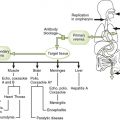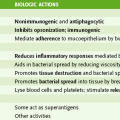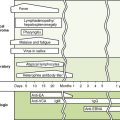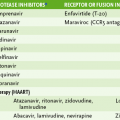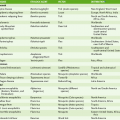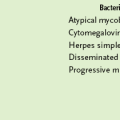Chapter 24 1. This family consists of large viruses with an enveloped, helical nucleocapsid and (–) RNA genome. 2. Viruses are distinguished by the types of glycoproteins. B Shared pathogenic properties • Viral attachment proteins bind to sialic acid or protein receptor. • A fusion (F) protein or activity promotes envelope fusion with target cell membrane and release of nucleocapsid into cytoplasm. • Epithelial cells of the upper respiratory tract are the site of initial infection by paramyxoviruses. • Viremic spread of measles virus and mumps virus leads to infection in various sites throughout the body. • No viremia occurs with parainfluenza virus and RSV, which remain localized to the respiratory tract. 3. Formation of multinucleated cells (syncytia) • Infected cells form syncytia, which allow cell-to-cell spread of virions and evasion of antibodies. • Measles virus is a strictly human virus with only one serotype. Infection is usually diagnosed clinically. • Viremic spread from upper respiratory tract and local lymph nodes can lead to infection of the conjunctiva, urinary tract, small blood vessels, lymphatic system, and central nervous system (CNS). 2. Measles clinical manifestations • This serious febrile illness has an incubation period of 7 to 13 days. • Prodromal symptoms include cough, coryza (acute rhinitis), and conjunctivitis (3 Cs). • Koplik’s spots (diagnostic) appear on buccal membrane after 2 days and last for 1 or 2 days. • Extensive maculopapular rash, appearing 12 to 24 hours after the Koplik spots, starts below the ears and spreads over the body. 3. Complications of measles infection • Secondary bacterial infections can cause pneumonia, which accounts for 60% of deaths from measles infection. • Acute postinfectious encephalitis, an immune-mediated demyelinating disease, has a mortality rate of 15%. • SSPE, a rare, slow viral infection occurring months to years after primary infection, is caused by defective measles virus in the brain. • Diagnosis usually made from symptoms • Confirmation by reverse transcriptase–polymerase chain reaction (RT-PCR) • Immunofluorescence of cells in urinary sediment or pharyngeal cells • Measles, a highly contagious disease, is spread by virion-containing respiratory droplets both before and after symptoms of infection occur. • Live attenuated vaccine is given at 15 to 24 months of age and again before entering elementary or junior high school as part of the MMR triple vaccine. a. Use of killed vaccine is associated with more severe, atypical measles infection on exposure to virus. • Passive immunization with immune serum globulin is effective in protecting unvaccinated immunocompromised children after exposure to measles virus. • Mumps virus exists as a single serotype and only infects humans. • Initial infection in the upper respiratory tract spreads to parotid glands. • Subsequent viremia can spread infection to the testes, ovaries, thyroid, pancreas, and CNS (in 50% of cases). 2. Mumps clinical manifestations • Infection with mumps virus often is asymptomatic or accompanied by mild nonspecific symptoms. • Fever, sudden onset of bilateral swelling of the parotid glands (parotitis), and redness and swelling of the ostium of Stensen duct mark acute disease. • Orchitis, oophoritis, pancreatitis, and CNS infection may occur after a few days.
Large Enveloped RNA Viruses
![]()
Stay updated, free articles. Join our Telegram channel

Full access? Get Clinical Tree



